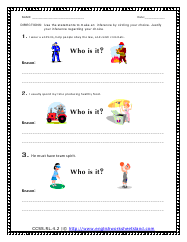Making Inferences Worksheets To Print:
Where am I? - Try to find the location of where this story happens. Write where you think the passage in happening and explain your answer.
Who am I? - This is a picture activity. Come to a conclusion by circling the correct image.
Who am I Not? - Fires or criminals, I'm not sure which is more harmful. Use the statements to make an inference by circling your choice. Justify your inference regarding your choice.
Where are we? - A picnic and adventure story. Where does the story take place? How do you know?
Where are we? Revisited - His mouth hit the floor? That is just a hyperbole now isn't?
Drawing Conclusions - Following squirrels around is a tough business.
Reading Passage - Read each paragraph below and answer the inference question that follows. Read the story about the squirrel and his acorns.
Figure it Out - Mark the correct answer by looking deep into each sentence.
Making Inferences - Read about Josh and his dad. Then write about what you think Josh and his dad will do.
Reading Passage 2 - The inferences here are quite simple. Pay particular attention to the quotes.
Drawing Conclusions - Decide if each sentence about the story is true or false and write your answer at the end of the sentence.
What's going on? - James was the first boy in Miss Lane's class to find red sports on his face and arms.
Making a Call - You can be the judge of this one. What do you think will happen next?
From the Text - You will choose a selection of text and see what you feel is going on.
When Writing - Look at the picture. Write a paragraph from the stormtrooper's point of view. Do not use the words toy or Lego. Allow the reader to infer that the POV character is a toy.
What to Do? - Draw a picture of what you think Wendy and her mother are going to do.
Too Many Details - Writing is most interesting to a reader if they are allowed to figure some things out for themselves rather than writing down every single detail about what is going on.
George's Friends - You will make educated guesses and show how you came about them.
What Time Is It? - Read each sentence and see if you can determine the time of day the event is taking place.
In Home - We provide you with picture inside people's homes. What can you tell about those people from the pictures?
My Location - Write down as many concrete things about your location as you can think of. Try to think of at least one thing for each of the five senses.
Reading Passages - We put this skill to practical use.
Fall Scene - Look at the picture. Write a paragraph from which the reader can infer the location.
Short Entry Practice - You will breakdown a paragraph and make sense of it for yourself.
Character Thoughts - Describe the character's personality. Write down what the text specifically says about your character. Quote explicitly from the text to support your answer.
Where Are You? - Read each passage. Where is it taking place? Write your answer on the line. Briefly explain your answer.
By the Book - Fill in the chart below to make a solid deduction from the text provided.
Your Thoughts In a Sentence - Make a conclusion from each sentence.
More Inference Worksheet Topics:
Citing Textual Evidence- This shows students how to validate their argument with facts.
Creating Inferences From What We Read- How to spot the claims and arguments you can make in written text.
Drawing Inferences- How to mount a substantial claim with facts.
Drawing Inferences From Text- How do you frame this picture for your audience?
Explaining A Story From Illustrations- Pictures can lead us to make claims that we can validate as well.
Interpreting And Inferring From Text- This is not the easiest process for students, but they can come across some good tips here.
Making Inferences From Text- The big message here is to build off of your prior knowledge.
Evaluating Claims In A Text- We lead students down a path to find where to look.
Explaining Details and Drawing Inferences From Text- Paying attention to the finest of details can score you a lot of points here.
Fact Based Concluding Statements- When you hit them with facts, it makes it difficult for them to counter it.
Pronunciation and Meaning of Words With References- In this case, we show you how to pronounce words when given a reference source.
Textual Evidence- What is it and how to locate it within a thick passage?
Using Evidence To Support Claims- This is a starter kit for writers. You will begin to understand how to use them in your writing.
Using Illustrations and Details For Key Ideas- How can we use drawings to validate our points?
Supporting Evidence- How to develop a solid sack of evidence.
Using Illustrations and Details to Describe Stories- This is where we take a mixture of drawings and text to mount our point.
Using Parts of A Story To Infer- In most cases, you will need to flash a position between two parts of the story.
Using Textual Evidence- How to reword the evidence to prepare a clear position about your point.
Using Quotes From Text- How to you locate them and how do you arrange them for your readers?
Validating Claims With Evidence- How much evidence is enough and how should you present it?
Writing Arguments to Support Evidence- This is what attorneys do all day long.
Writing Evidence To Support Your Opinion- Sometimes it is not the evidence itself, but how it is displayed that make it valid.
Get FREE English Worksheets In Your Email

